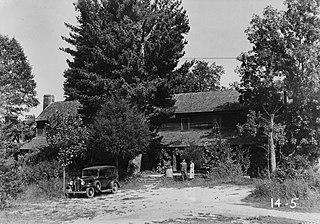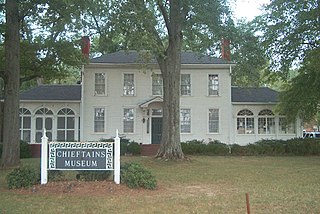
Butts County is a county located in the central part of the U.S. state of Georgia. As of the 2010 census, the population was 23,655. The county seat is Jackson. The county was created on December 24, 1825.
Hermitage, The Hermitage or L'Hermitage may refer to:

Ocmulgee Mounds National Historical Park in present-day Macon, Georgia, United States preserves traces of over ten millennia of culture from the Native Americans in the Southeastern Woodlands. Its chief remains are major earthworks built before 1000 CE by the South Appalachian Mississippian culture These include the Great Temple and other ceremonial mounds, a burial mound, and defensive trenches. They represented highly skilled engineering techniques and soil knowledge, and the organization of many laborers. The site has evidence of "17,000 years of continuous human habitation." The 3,336-acre (13.50 km2) park is located on the east bank of the Ocmulgee River. Present-day Macon, Georgia developed around the site after the United States built Fort Benjamin Hawkins nearby in 1806 to support trading with Native Americans.
Indian Springs may refer to:

New Echota was the capital of the Cherokee Nation in the Southeast United States from 1825 to their forced removal in the late 1830s. New Echota is located in present-day Gordon County, in northwest Georgia, 3.68 miles north of Calhoun. It is south of Resaca, next to present day New Town, known to the Cherokee as Ustanali. The site has been preserved as a state park and a historic site. It was designated in 1973 as a National Historic Landmark District.

Travelers Rest State Historic Site is a state-run historic site near Toccoa, Georgia. Its centerpiece is Traveler's Rest, an early tavern and inn. It was designated a National Historic Landmark on January 29, 1964, for its architecture as a well-preserved 19th-century tavern, and for its role in the early settlement of northeastern Georgia by European Americans.

Menawa, first called Hothlepoya, was a Muscogee (Creek) chief and military leader. He was of mixed race, with a Creek mother and a fur trader father of mostly Scots ancestry. As the Creek had a matrilineal system of descent and leadership, his status came from his mother's clan.

The Kolomoki Mounds is one of the largest and earliest Woodland period earthwork mound complexes in the Southeastern United States and is the largest in Georgia. Constructed from 350CE to 600CE, the mound complex is located in southwest Georgia, in present-day Early County near the Chattahoochee River.

Glenn Springs is an unincorporated community in Spartanburg County, South Carolina, United States, located at a spring. The healing waters of the Glenn Springs were known around the country for over one hundred years. It was said that the waters would heal almost any illness. It is even said that the Indians came to the springs for its healing powers. In the late 18th century, the land around the springs was granted to a Henry Storey by the king. Even George Washington was said to have stopped there to try the waters on a trip to Georgia.
America's 11 Most Endangered Places or America's 11 Most Endangered Historic Places is a list of places in the United States that the National Trust for Historic Preservation considers the most endangered. It aims to inspire Americans to preserve examples of architectural and cultural heritage that could be "relegated to the dustbins of history" without intervention.

Red Clay State Historic Park is a state park located in southern Bradley County, Tennessee established in 1979. The park is also listed as an interpretive center along the Cherokee Trail of Tears. It encompasses 263 acres (1.06 km2) of land and is located just above the Tennessee-Georgia stateline.

Fort Mitchell Historic Site is a park and an archaeological site in Fort Mitchell, Alabama, that was declared a National Historic Landmark in 1990. The park features a reconstruction of the 1813 stockade fort that was an important United States military post in the Creek War, a museum with exhibits about the fort's history, and a collection of historic carriages, a restored 19th-century log home, and a visitor center.

Chieftains Museum, also known as the Major Ridge Home, is a two-story white frame house built around a log house of 1792 in Cherokee country. It was the home of the Cherokee leader Major Ridge. He was notable for his role in negotiating and signing the Treaty of New Echota of 1835, which ceded the remainder of Cherokee lands in the Southeast to the United States. He was part of a minority group known as the Treaty Party, who believed that relocation was inevitable and wanted to negotiate the best deal with the United States for their people.

Brookside Museum, sometimes known as the Aldridge House, is located on the western edge of downtown Ballston Spa, New York, United States. It is a wooden house built in 1792, one of the oldest in the village, but modified since then.

Sharon Springs Historic District is a national historic district located at Sharon Springs in Schoharie County, New York. The district includes 167 contributing buildings and nine contributing structures. It encompasses all of what remains of the historic mineral water spa, including commercial, institutional, and residential properties associated with its resort function during the period, ca. 1825–1941. The focus of the district is a group of mineral springs that together constitute the world-famous spa for which the village was named. Notable buildings include the Magnesia Temple (1863), Chalybeate Temple (1920s), Lower Bath House, Inhalation Bath House, Imperial Bath House (1927), Adler Hotel (1928), and Roseboro Hotel. Also located in the district is the separately listed American Hotel.
The Treaty of Indian Springs, also known as the First Treaty of Indian Springs and the Treaty with the Creeks, is a treaty concluded between the Muscogee and the United States on January 8, 1821 at what is now Indian Springs State Park.
The Treaty of Indian Springs, also known as the Second Treaty of Indian Springs and the Treaty with the Creeks, is a treaty concluded between the Muscogee and the United States on February 12, 1825 at what is now the Indian Springs Hotel Museum.

Historic Hotels of America is a program of the National Trust for Historic Preservation that was founded in 1989 with 32 charter members; the programs accepts nominations and identifies hotels that have maintained their authenticity, sense of place, and architectural integrity. As of June 5, 2015, the program included over 260 members in 44 states, including the District of Columbia, Puerto Rico, and the U.S. Virgin Islands.















